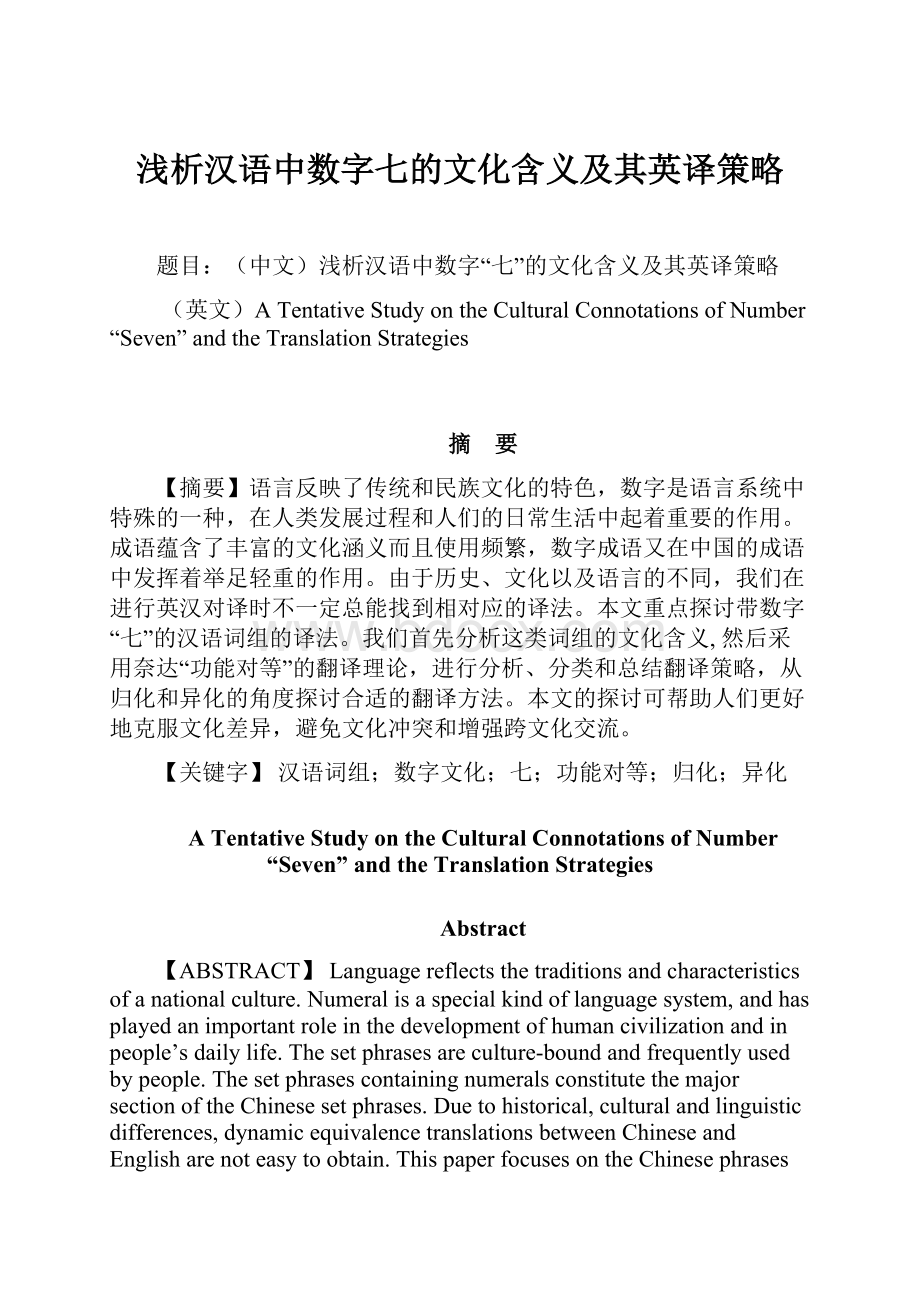浅析汉语中数字七的文化含义及其英译策略.docx
《浅析汉语中数字七的文化含义及其英译策略.docx》由会员分享,可在线阅读,更多相关《浅析汉语中数字七的文化含义及其英译策略.docx(20页珍藏版)》请在冰豆网上搜索。

浅析汉语中数字七的文化含义及其英译策略
题目:
(中文)浅析汉语中数字“七”的文化含义及其英译策略
(英文)ATentativeStudyontheCulturalConnotationsofNumber“Seven”andtheTranslationStrategies
摘 要
【摘要】语言反映了传统和民族文化的特色,数字是语言系统中特殊的一种,在人类发展过程和人们的日常生活中起着重要的作用。
成语蕴含了丰富的文化涵义而且使用频繁,数字成语又在中国的成语中发挥着举足轻重的作用。
由于历史、文化以及语言的不同,我们在进行英汉对译时不一定总能找到相对应的译法。
本文重点探讨带数字“七”的汉语词组的译法。
我们首先分析这类词组的文化含义,然后采用奈达“功能对等”的翻译理论,进行分析、分类和总结翻译策略,从归化和异化的角度探讨合适的翻译方法。
本文的探讨可帮助人们更好地克服文化差异,避免文化冲突和增强跨文化交流。
【关键字】汉语词组;数字文化;七;功能对等;归化;异化
ATentativeStudyontheCulturalConnotationsofNumber“Seven”andtheTranslationStrategies
Abstract
【ABSTRACT】Languagereflectsthetraditionsandcharacteristicsofanationalculture.Numeralisaspecialkindoflanguagesystem,andhasplayedanimportantroleinthedevelopmentofhumancivilizationandinpeople’sdailylife.Thesetphrasesareculture-boundandfrequentlyusedbypeople.ThesetphrasescontainingnumeralsconstitutethemajorsectionoftheChinesesetphrases.Duetohistorical,culturalandlinguisticdifferences,dynamicequivalencetranslationsbetweenChineseandEnglisharenoteasytoobtain.ThispaperfocusesontheChinesephrasesinvolvingnumber“seven”andpenetratestheculturalconnotationsofthiskindofphrases.GuidedbyNida’s“dynamicequivalence”theory,wearegoingtoanalyze,categorizeandconcludeitstranslationmethod,andprobeintotheappropriatetranslationstrategiesofnumeralphrases,especiallytheseven-involvedphrases,fromtheperspectivesofnaturalizationandforeignization.Throughourstudy,wemayhelppeopletoovercomeculturaldifferences,eliminateculturalconflictsandenhancepeople’sinter-culturalcommunication.
【KEYWORDS】Chinesephrases;numeralculture;seven;dynamicequivalence;naturalization;foreignization
Contents
AbstractIII
1.Introduction.....1
2.Abriefsurveyoftheculturalconnotationsofnumbers..........2
2.1Abriefcontrastiveexplicationofsomesinglenumbersacrosscultures..................................3
2.1.1Reviewonothernumbersinculturesbothhomeandabroad………………….……………….3
2.1.2Theculturalconnotationsofnumber“seven”……………………………….………………..5
2.2Areviewonnumber“seven”inChineseidiomsandphrases…………......…………….....…..5
2.3Areviewontheinfluenceofnumber“seven”inWesterncountry…….………….....……..6
3.Nida’stranslationtheory—dynamicequivalenceandtworelatedtranslationstrategies….……………….6
3.1Dynamicequivalence………………………………………………………………....………………6
3.2Twotranslationstrategies:
naturalizationandforeignization.............................................................7
3.3Differentviewsofnaturalizationandforeignization………………………………………………...8
4.Translationstrategiesofseven-involvedChinesephrases..............................................................................8
4.1Literalseven-involvedChinesePhrases………….............................................................................9
4.2Cultural-boundseven-involvedChinesephrases............................................................................10
4.2.1Non-figurativeseven-involvedterms……............................................................................10
4.2.2Seven-involvedfigurativesetphrases.........................................................................12
5.Conclusion…………......................………………………………………………………………………..15
References…………….............................…………………………………………………………………16
Acknowledgements.……………...........……………………..…………......………………………………17
ATentativeStudyontheCulturalConnotationsofNumber“Seven”andtheTranslationStrategies
1.Introduction
Languageisnotonlyapartofsociety,butalsoakindofculturephenomenon.Bothasalinguisticandculturalphenomenon,itisworthstudying.Anylanguage,withoutexception,reflectsthetraditionsandcharacteristicsofanationalculture,andisfullofthespiritofthatculture,abletorepresenttheworldviewofthatnation.Numeralisaspecialkindoflanguagesystemandplaysanimportantroleinthedevelopmentofhumancivilizationandinpeople’sdailylife.Thisthesisismainlyabouttheculturalconnotationsofnumbers,especiallythenumber“seven”.GuidedbyNida’s“dynamicequivalence”theory,thisthesisdiscussestheappropriatetranslationstrategiesoftheseven-involvedphrasesinChinese.
Therearelotsofarticlesdiscussingabouttheculturalconnotationsofnumbersindifferentculturesbothhomeandabroad,includingthesesofsomepostgraduates.Someacademicjournalscarryarticlesthatareaboutthetranslationmethodsofnumber-involvedphrases.Therearemanykindsofdifferentdictionariesthathavespeciallexicalentitiesofnumber-involvedexpressions.Bycategorizingandanalyzingthesematerials,wecanhelppeopleknowtheculturaldifferencesbetweenChineseandEnglish,thereforeovercomeculturalconflictsandimprovepeople’sinter-culturalcommunication.
Thisthesisfocusesonstudyingtheconnotationsofdifferentnumbers,withspecialreferencetothenumber“seven”.Beforeundertakingtheenterpriseofdiscussingnumber“seven”andthetranslationmethodsrelatedtoseven-involvedphrases,theauthorwillpresentatentativereviewontheChineseseven-involvedphrase.ThedataarefromtheNewCenturyChinese-EnglishDictionaryeditedbyHuiYu(HuiYu2005).Duringthethedatacollectionperiod,theauthorfoundthatalthoughtherearemanyarticlesaboutnumeralculture,fewaredevotedtothediscussionofnumber“seven”andtheirspecifictranslationstrategiesbasedondifferentsituations,letaloneacomprehensivestudyofnumbersevenandthepropertranslationmethods.Asaresult,thisthesiswillaimatathoroughprobeintothisproblem.Thetheoryisdynamicequivalenceandtheconcretemethodsarenaturalizationandforeignization.
2.ABriefSurveyoftheCulturalConnotationsofNumbers
ChineseandEnglishculturesarequitedifferentfromeachother,thedifferencesarereflectedintherespectivelanguagesandgetexpressedbymeansofwords,phrase,sayingsandsoon.Thus,thetwolanguageshavebecomethecarrierandcontainerofthetwocultures.Atthesametime,thetwoculturesarethesoilthatthetwolanguagesexistin.Inotherwords,therewouldbenolanguageiftherewerenoculture.
TheinterrelatednessoflanguageandcultureareperfectlyreflectedinNida'swords:
...Themeaningofverbalsymbolsonanyandeveryleveldependsonthecultureofthelanguagecommunity.Languageisapartofculture,andinfactitisthemostcomplexsetofhabitsthatanycultureexhibits.Languagereflectstheculture,providesaccesstotheculture,andinmanyrespectsconstitutesamodelofculture(qtd.MaHuijun,75).
However,whateverkindofcultureitmaybe,onceitbeginstocomeintoexistence,itmustbespread,exchanged,continuedanddeveloped.
Numbers,asweusuallyknow,couldalsobeviewedasapartoflanguageandarefrequentlyappliedinthescientificfieldwithitsnatureofexactness.Nowadaysnumbersareusedbythewholehumanity,sothatcultureofnumbershascomeintobeing.AsfarasChinesecultureisconcerned,itbearsthesimilaritytotheworldculture,butChinesecultureattachesimportancetothewideuseofculturalelements.Numbersevenissuchaculturalelement.ItisrootedinancientChinesecultureandhasaccumulatedabundantconnotationinthedevelopmentofChineseculture.
Intermsofapplication,numeralcultureisfoundinmanyfields:
politics,economy,history,geography,astronomy,marriage,religion,etc.Whyarenumberssowidelyused?
Sincenumbersareendowedwithdifferentkindsofmysteriousandexoticmeanings,andnumeralsetphrasesusedinourdailylifecanalsoconveysomephilosophicalandculturalconnotations.
Peopleindifferentculturalbackgroundsowndifferentviewsonnumbers.Forinstance,Chinesehasmoreuseofnumbersandricheraccumulationofsetnumberphrases,idioms,proverbsandsayings.Englishhasfeweruseofnumber.Whatunderliesthedifferenceisstillunknownandawaitsexploration.
2.1ABriefExplicationofSomeSingleNumbersinDifferentCultures
2.1.1ReviewonOtherNumbersinCulturesBothHomeandAbroad
Inhuman’sinterculturalactivity,allparticipativepartiesnotonlyneedtobefamiliarwithnationallanguageandculture,butalsomustfullyunderstandthelanguageandcultureoftheoppositeparty,speciallythedifferencebetweenone'snationalcultureandother’sculture.Onlyholdingthisopinioncanonemakethehumancommunicationworksmoothly.(ZhouZhipei2003:
480)(Translationoftheoriginalbytheauthor).Inthissection,thegeneralculturerelatedtodifferentnumbersaresurveyed.
Thenumber“three”isusedwidelyinChina.“Three”iswrittenas“三”inChinesecharacter,inwhichthefirstlineisconsideredtorepresentthesky,themiddlelinesymbolizeshumanbeing,andthelastlinerepresentstheearth(ZhaoXiang2005:
90).Inthehistory,humangraduallyrecognizedthattimeisdividedintothreeparts:
thepast,thepresent,thefuture;spacehastop,middle,bottom.Undersuchacognitionoftimeandspace,“three”isendowedwithlotsofmeaningsinChinesecultureandalsoconsequentlywidelyusedinvariousfields:
thenavy,thearmy,theairforcearecalled“threeArmedForce”(三军);cattle,sheepandpigsarenamed“threedomesticanimals”(三牲);DragonBoatFestival,theMid-autumnFestivalandtheSpringFestivalconstitute“threefestival”(三节)(HuiYu2005).Thenumber“three”isalsorespectedbyWesternpeople.Theyholdtheideathattheworldconsistsofthreeelements,theearth,theoceansandthesky.Thenatureisconstitutedofthreeelements:
animals,plantsandminerals(DuanPing2006:
208);theChristiansthinktherearetheFather,theSonandtheHolySp